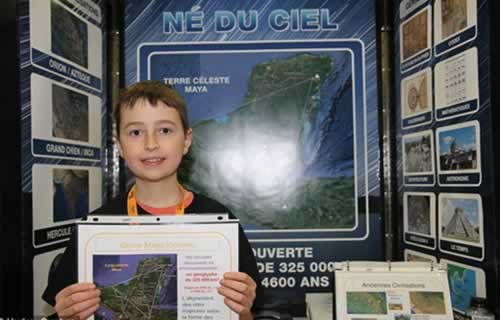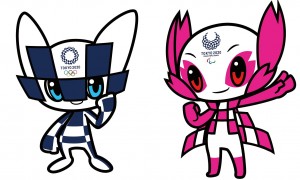导读:William Gadoury是一名来自加拿大魁北克地区的15岁少年,他发现在墨西哥东南部尤卡坦半岛丛林深处,埋藏着一座玛雅文明的失落之城。他并没有租赁一系列昂贵的设备,也没有跳上飞机并跑到挖掘现场忙碌。他只是舒舒服服地待在家里,将天上恒星的位置与这些古老的城市一一对应了起来。

They may have lived some 1,700 years ago, but the ancient Maya had an incredible knowledge of celestial bodies, which they believed influenced everything from harvest to death.
古玛雅人也许生活在距今1700多年前,不过他们对天文学却着让人难以置信的研究,在玛雅的信仰里,天文学可以影响一切,从丰收到死亡。
Now a 15-year-old boy has studied astronomical charts devised by these ancient Mexican people, as well as satellite photos, to pinpoint the location of a forgotten Mayan city.
现在,一个15岁的男孩通过观察由古墨西哥人绘制出来的星图,结合卫星图像,发现了一座失落的玛雅古城。
William Gadoury, from Quebec has named the ’lost city’ in the Yucatan jungle K’aak Chi, or Mouth of Fire.
来自加拿大魁北克的15岁男孩William Gadoury将这座在尤卡坦丛林中发现的失落玛雅古城命名为“烈火之口”。
Satellite images suggest the lost city could be among the largest built by the ancient civilisation, which thrived between 300 and 700 AD.
卫星图像显示,这座古城有可能是公元300年到公元700年间兴盛的古文明时代最大的建筑。
Wondering why the ancient people built their cities far away from rivers and in inhospitable mountains prompted the teenager to look to the sky for answers, because the Mayans worshiped the stars”
为何玛雅人建立城市时会远离河流,选择深山中的热带丛林?这激起了William的好奇心,又因为玛雅人崇拜恒星,他开始研究星象图以找寻谜底。
Incredibly, the brightest of the stars match up with the largest cities.
不可思议的是,最亮的星星恰好就代表的是那些主城。
‘I was really surprised and excited when I realised that the most brilliant stars of the constellations matched the largest Maya cities.’ He told The Journal of Montreal.
他告诉蒙特利尔日报,“当我发现那些最亮的星座正好对应玛雅那些大城市时,我惊奇不已。”
He is said to be the first to make the connection, which could lead to further finds.
据称William是第一个发现这种对应关系的人,这项发现会通向更进一步、更深层次的研究。
It was in the 23rd constellation, containing three stars, that he found two matching cities on the map, suggesting one has not yet been re-discovered.
他就是在研究第23张星座图时发现了问题:图中有三颗星星,但只有两颗能与已知古城对上号,意味着第三颗星极未有可能尚未被发掘。
To investigate further, he used satellite images from the Canadian Space Agency and Google Earth to search the dense jungle for any signs of buildings.
为了深入调查,他使用加拿大太空局提供的卫星图片和谷歌地球上的图像,在茂密的丛林中寻找建筑物的迹象。
The photographs revealed linear features that ‘stuck out,’ Daniel De Lisle, from the Canadian Space Agency told The Independent.
加拿大太空局的Daniel De Lisle告诉独立报,照片显示出“醒目的”线性特征。
‘There are linear features that would suggest there is something underneath that big canopy,’ he said.
他说,这意味着苍穹之下,那里一定有什么东西。
Armand La Rocque, from the University of New Brunswick believes one of the images shows network of streets leading to a large square, which may be a pyramid.
来自新不伦瑞克大学的专家Armand Larocque认为,其中一张图片显示出的街道布局通向一个大广场,极有可能是一座金字塔。
‘A square is not natural, it is mostly artificial and can hardly be attributed to natural phenomena,’ he said.
他说,“广场并非天然形成,很可能是人工造的,不太可能是自然现象所致。”
It’s possible 30 buildings accompany an impressive pyramid at the site.
除了这座让人惊叹的金字塔,此处可能还有30栋建筑。
If true, the lost city would be one of the five largest known to archaeologists, built by the Mayans.
如果被验证属实,那座古城将会是考古学家已知的、玛雅的第五大城市。
linking the position of stars and the location of a lost city and the use of satellite images on a tiny territory to identify the remains buried under dense vegetation, is quite exceptional.’
将星座的位置与失落的古城联系起来,使用一小块地域的卫星图象,以鉴别掩埋在浓密植被下的遗址,这真的是让人非常意外。
Dr la Rocque thinks William Gadoury’s technique could lead archaeologists to pinpointing the location of more possible lost Mayan metropolises.
Dr la Rocque认为,考古学家或许能借鉴William的这种技术,发掘出更多的玛雅失落古城。
The teenager would like to see the Mayan’s Mouth of Fire for himself and as yet, no-one has ventured into the jungle to confirm his ‘find’.
这个少年想亲自去见证玛雅的“烈火之口”,然而,还没有人冒险到丛林中去验证他的“发现”。
Gadoury’s discovery will be presented at Brazil’s International Science fair in 2017 and published in a journal.
William的这个发现会在2017年巴西国际科学技术博览会上展出,并出版在一个杂志上。







